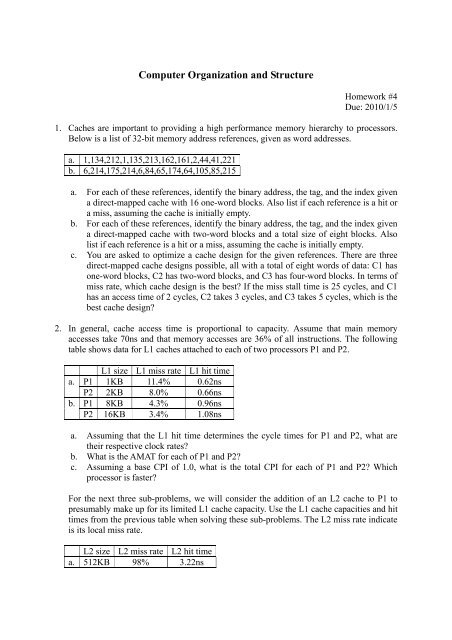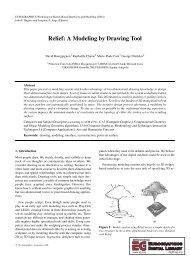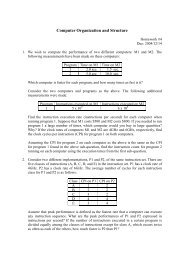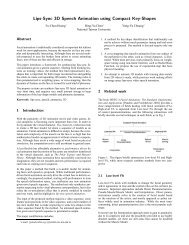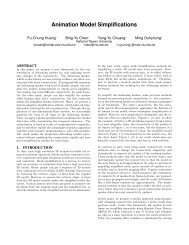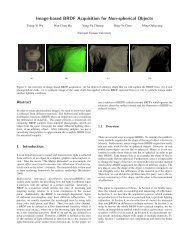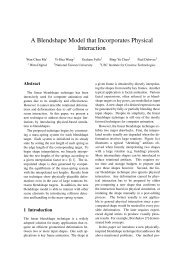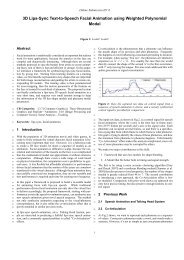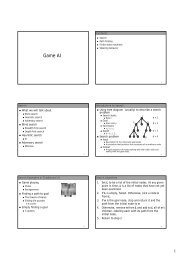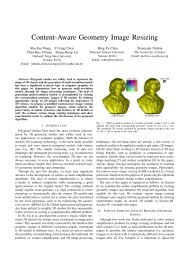Computer Organization and Structure - Computer Graphics Laboratory
Computer Organization and Structure - Computer Graphics Laboratory
Computer Organization and Structure - Computer Graphics Laboratory
- No tags were found...
Create successful ePaper yourself
Turn your PDF publications into a flip-book with our unique Google optimized e-Paper software.
<strong>Computer</strong> <strong>Organization</strong> <strong>and</strong> <strong>Structure</strong><br />
Homework #4<br />
Due: 2010/1/5<br />
1. Caches are important to providing a high performance memory hierarchy to processors.<br />
Below is a list of 32-bit memory address references, given as word addresses.<br />
a. 1,134,212,1,135,213,162,161,2,44,41,221<br />
b. 6,214,175,214,6,84,65,174,64,105,85,215<br />
a. For each of these references, identify the binary address, the tag, <strong>and</strong> the index given<br />
a direct-mapped cache with 16 one-word blocks. Also list if each reference is a hit or<br />
a miss, assuming the cache is initially empty.<br />
b. For each of these references, identify the binary address, the tag, <strong>and</strong> the index given<br />
a direct-mapped cache with two-word blocks <strong>and</strong> a total size of eight blocks. Also<br />
list if each reference is a hit or a miss, assuming the cache is initially empty.<br />
c. You are asked to optimize a cache design for the given references. There are three<br />
direct-mapped cache designs possible, all with a total of eight words of data: C1 has<br />
one-word blocks, C2 has two-word blocks, <strong>and</strong> C3 has four-word blocks. In terms of<br />
miss rate, which cache design is the best If the miss stall time is 25 cycles, <strong>and</strong> C1<br />
has an access time of 2 cycles, C2 takes 3 cycles, <strong>and</strong> C3 takes 5 cycles, which is the<br />
best cache design<br />
2. In general, cache access time is proportional to capacity. Assume that main memory<br />
accesses take 70ns <strong>and</strong> that memory accesses are 36% of all instructions. The following<br />
table shows data for L1 caches attached to each of two processors P1 <strong>and</strong> P2.<br />
L1 size L1 miss rate L1 hit time<br />
a. P1 1KB 11.4% 0.62ns<br />
P2 2KB 8.0% 0.66ns<br />
b. P1 8KB 4.3% 0.96ns<br />
P2 16KB 3.4% 1.08ns<br />
a. Assuming that the L1 hit time determines the cycle times for P1 <strong>and</strong> P2, what are<br />
their respective clock rates<br />
b. What is the AMAT for each of P1 <strong>and</strong> P2<br />
c. Assuming a base CPI of 1.0, what is the total CPI for each of P1 <strong>and</strong> P2 Which<br />
processor is faster<br />
For the next three sub-problems, we will consider the addition of an L2 cache to P1 to<br />
presumably make up for its limited L1 cache capacity. Use the L1 cache capacities <strong>and</strong> hit<br />
times from the previous table when solving these sub-problems. The L2 miss rate indicate<br />
is its local miss rate.<br />
L2 size L2 miss rate L2 hit time<br />
a. 512KB 98% 3.22ns
. 4MB 73% 11.48ns<br />
d. What is the AMAT for P1 with the addition of an L2 cache Is the AMAT better or<br />
worse with the L2 cache<br />
e. Assuming a base CPI of 1.0, what is the total CPI for P1 with the addition of an L2<br />
cache<br />
f. Which processor is faster, now that P1 has an L2 cache If P1 is faster, what miss<br />
rate would P2 need in its L1 cache to match P1’s performance If P2 is faster, what<br />
miss rate would P1 need in its L1 cache to match P2’s performance<br />
3. The following table is a stream of virtual addresses as seen on a system. Assume 4KB<br />
pages, a four-entry fully associative TLB, <strong>and</strong> true LRU replacement. If pages must be<br />
brought in from disk, increment the next largest page number.<br />
a. 4095,31272,15789,15000,7193,4096,8912<br />
b. 9452,30964,19136,46502,38110,16653,48480<br />
TLB<br />
Valid Tag Physical Page Number<br />
1 11 12<br />
1 7 4<br />
1 3 6<br />
0 4 9<br />
Page table<br />
Valid Physical page or in disk<br />
1 5<br />
0 Disk<br />
0 Disk<br />
1 6<br />
1 9<br />
1 11<br />
0 Disk<br />
1 4<br />
0 Disk<br />
0 Disk<br />
1 3<br />
1 12<br />
a. Given the address stream in the table, <strong>and</strong> the shown initial state of the TLB <strong>and</strong><br />
page table, show the final state of the system. Also list for each reference if it is a hit<br />
in the TLB, a hit in the page table, or a page fault.<br />
b. Repeat the above sub-problem, but this time use 16KB pages instead of 4KB pages.<br />
What would be some of the advantages of having a larger page size What are some<br />
of the disadvantages
c. Show the final contents of the TLB if it is two-way set-associative. Also show the<br />
contents of the TLB if it is direct-mapped Discuss the importance of having a TLB<br />
to high performance. How would virtual memory accesses be h<strong>and</strong>led if there were<br />
no TLB<br />
There are several parameters that impact the overall size of the page table. Listed below<br />
are several key page table parameters.<br />
Virtual address size Page size Page table entry size<br />
a. 32 bits 4KB 4 bytes<br />
b. 64 bits 16KB 8 bytes<br />
d. Given the parameters in the table above, calculate the total page table size for a<br />
system running five applications that utilize half of the memory available.<br />
e. Given the parameters in the table above, calculate the total page table size for a<br />
system running five applications that utilize half of the memory available, given a<br />
two-level page table approach with 256 entries. Assume each entry of the main page<br />
table is 6 bytes. Calculate the minimum <strong>and</strong> maximum amount of memory required.<br />
f. A cache designer wants to increase the size of a 4KB virtually indexed, physically<br />
tagged cache. Given the page size listed in the table above, is it possible to make a<br />
16KB direct-mapped cache, assuming two words per block How would the<br />
designer increase the data size of the cache


